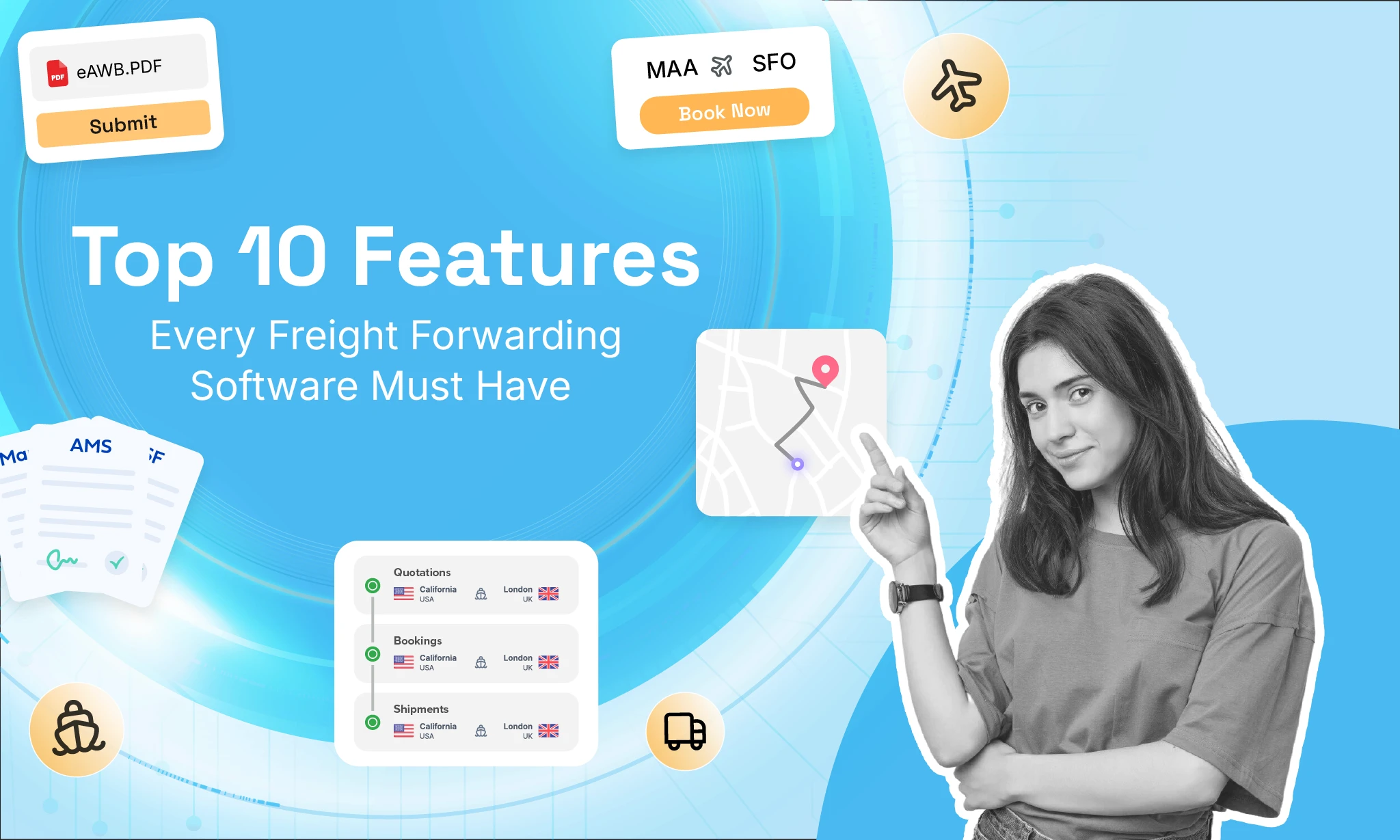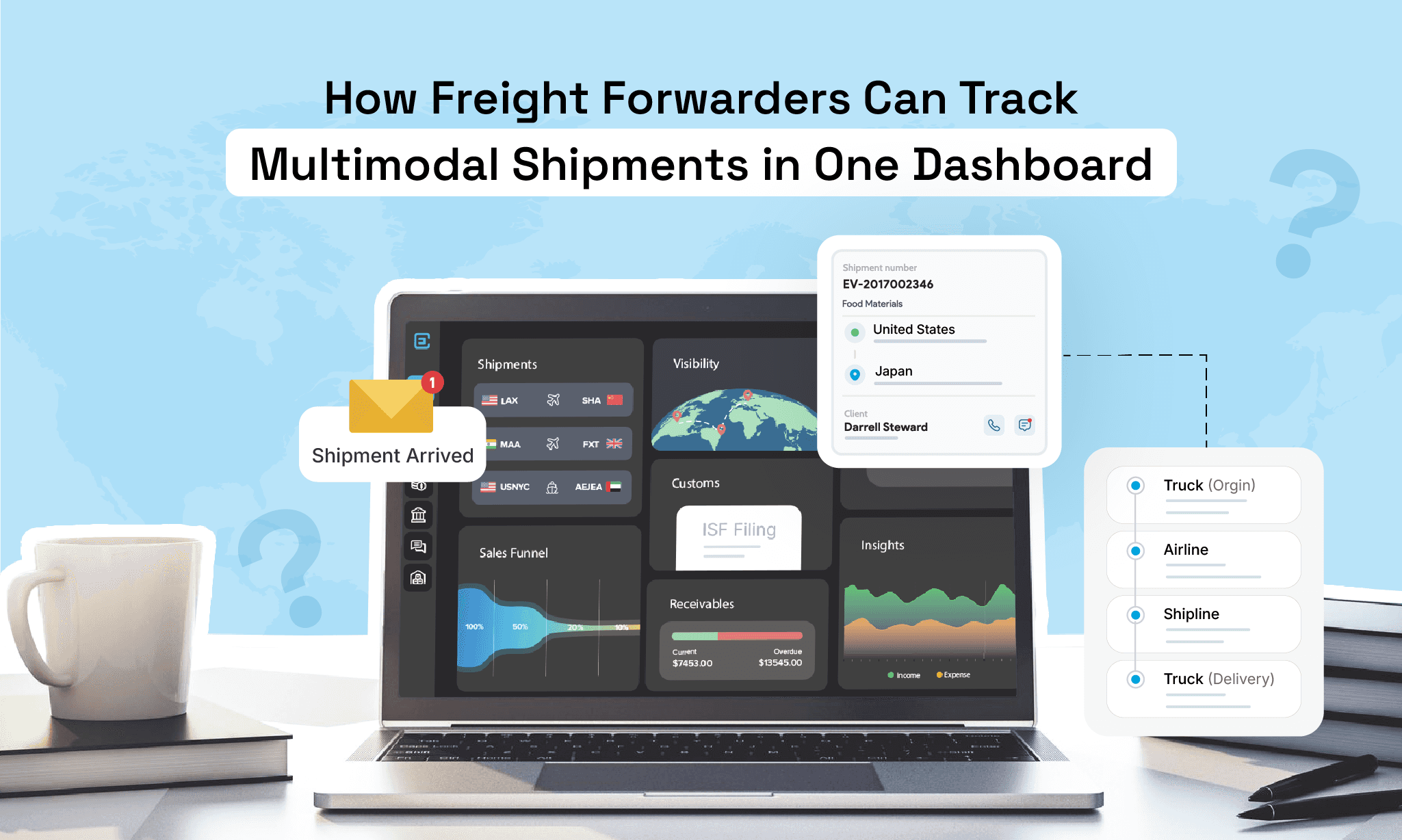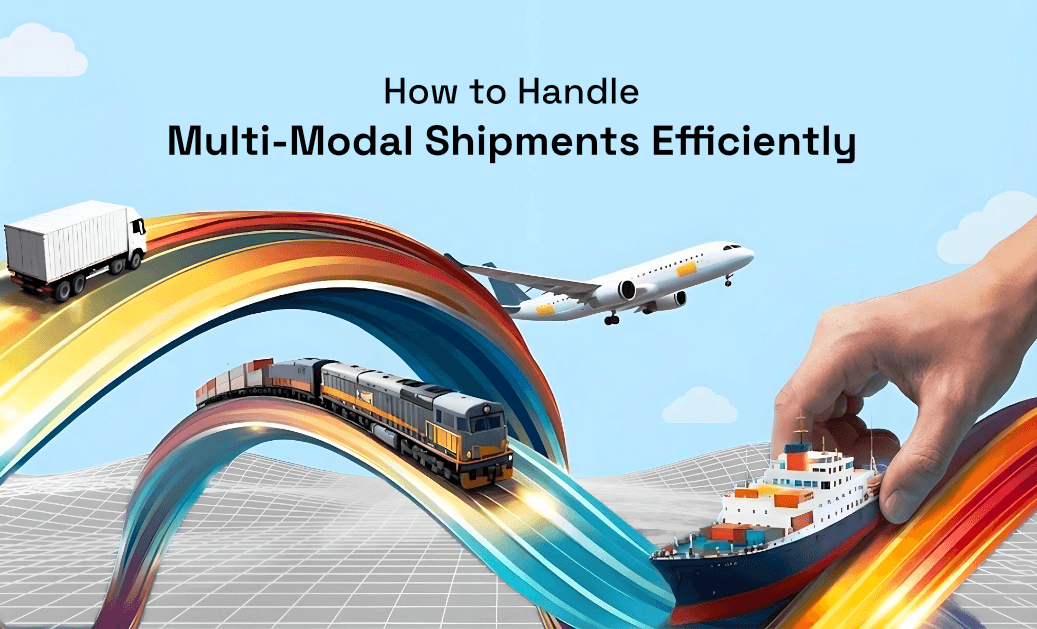How AI is Transforming Freight Management in 2025
Author:
Dharshini Balamurugan
Published On:
Jul 21, 2025
Updated On:
Jul 21, 2025
1 min read
The freight world is changing fast. Freight management is no longer just about moving goods from point A to point B. In 2025, it's about precision, visibility, real-time decisions, and predictive insights. What’s powering all of this? Artificial Intelligence.
AI has stepped in not just as a support system, but as a transformative technology. From route optimization and customs clearance to predictive maintenance and automated document generation, AI is reshaping every link in the freight chain.
Whether you’re a freight forwarder, 3PL, or a small logistics team, here’s how AI is making freight smarter, faster, and leaner.
Key Takeaways
Smarter routing & real-time visibility: AI uses live data to optimize routes and provide end-to-end shipment tracking, so you're always a step ahead.
Automated paperwork: From bills of lading to customs documents, AI handles the heavy lifting, cutting down on manual work and human error.
Demand forecasting & inventory planning: Predict future volumes, plan capacity, and avoid overstocking or last-minute scrambles.
Warehouse & asset optimization: AI improves picking, packing, and inventory flow while monitoring equipment for predictive maintenance.
Faster customer service: Chatbots, auto-alerts, and smart updates reduce the support load and keep clients in the loo
1. Smarter Route Optimization = Faster Deliveries

Freight doesn’t move blindly, it moves with data. Thanks to AI, route planning has gone from reactive to predictive. AI-powered freight systems today analyze live traffic feeds, GPS data, and satellite imagery to detect congestion or delays before they happen.
But it doesn’t stop there.
These systems also pull in weather forecasts, roadblock alerts, fuel pricing, and even political risk updates to recommend the most efficient delivery routes.
It’s not just about finding the shortest path anymore, it’s about finding the smartest one.
For example, if a cyclone is headed toward a port in Chennai or there’s a protest blocking access to a major highway in France, AI reroutes shipments through alternate ports or inland routes—all automatically. The system weighs every variable: fuel consumption, port congestion, customs processing time, and overall cost, giving freight forwarders a route that’s fast, safe, and cost-effective.
Take a Singapore-based forwarder shipping to Europe: if AI detects congestion at the Port of Rotterdam, it can recommend routing through Antwerp or Hamburg, adjusting schedules and notifying partners within seconds.
The result? Fewer delays, lower costs, and happy customers.
In an industry where minutes can cost thousands, this kind of precision isn’t just helpful, it’s transformative.
2. AI-Powered Forecasting: Know What’s Coming

In freight, unpredictability has always been part of the game, especially when it comes to demand. One week you’re short on containers, the next you’re overwhelmed. But in 2025, AI is taking the guesswork out of forecasting.
AI-powered systems now help logistics teams stay one step ahead by accurately predicting demand patterns, volume surges, container availability, and potential port slowdowns. These tools analyze data from shipment history, fuel trends, weather conditions, tariff changes, and even social media chatter to generate real-time, actionable insights.
And the results speak volumes.
One study from Quidget.ai notes that “AI forecasting systems have been shown to reduce errors by 20–50% compared to traditional methods,” with users reporting more accurate container orders and fewer surprise costs
Planning peak season shipments? AI already knows when your demand curve will spike. Worried about delays at a key port? AI alerts you days in advance based on congestion patterns. Even unexpected policy shifts or tariff updates are flagged as potential risks, giving your team time to pivot.
The result? More efficient bookings, smarter inventory movement, fewer surprise charges, and smoother cross-border operations. AI lets you plan like a chess master several moves ahead rather than scrambling at the last minute.
In a fast-moving industry, predictive intelligence is the new competitive edge.
3. Automation of Repetitive Tasks

Freight teams used to spend hours buried in paperwork generating invoices, entering customs data, validating documents, and updating shipment statuses.
AI has changed the narrative.
What once drained time and energy now takes minutes or even seconds.
Modern AI systems, powered by Natural Language Processing (NLP), can read, interpret, and process complex freight documents just like a human but with unmatched speed and accuracy. They automatically generate bills of lading, fill in customs forms, match invoices to shipments, and even reconcile payment discrepancies.
Need to update tracking info across five platforms? AI does it simultaneously. Managing multi-country compliance? The system checks requirements and fills out the right forms without missing a beat.
This level of automation doesn’t just cut down errors, it clears the deck for your team to focus on what actually moves the business forward: strategy, client relationships, and growth.
In an industry where every document matters and every delay costs, AI ensures that your paperwork runs in the background fast, flawless, and worry-free.
4. Real-Time Visibility and Tracking

“Where’s my shipment?” is now a baseline expectation.
AI has made real-time shipment tracking the industry standard. By integrating with Internet of Things (IoT) sensors, GPS, and satellite feeds, AI systems provide live location data for every shipment—whether it’s on a truck, ship, or plane.
These tools don’t just show you where your cargo is; they predict accurate ETAs, flag potential delays, and offer instant alerts if something goes off course. And it’s not just for internal teams. Shippers and customers now have access to intuitive dashboards that keep them in the loop from dispatch to delivery.
The result? Clear communication, fewer follow-ups, and smooth coordination across all parties involved. With AI managing visibility, logistics teams spend less time chasing updates and more time optimizing the journey ahead.
5. Predictive Maintenance = Fewer Breakdowns

In freight, a breakdown isn’t just a technical issue, it’s a chain reaction of delays, missed deadlines, and unhappy customers. That’s why AI-powered predictive maintenance is a game-changer.
AI systems now monitor every critical metric in real time, engine temperature, brake condition, fuel efficiency, and vibration levels inside containers and vehicles. By analyzing these data points, AI can detect patterns that signal a potential failure and schedule preventive maintenance before anything goes wrong.
What’s more, the system chooses the best maintenance window based on operational demand, ensuring minimal disruption. No more surprise breakdowns in the middle of a high-priority shipment.
With AI predicting mechanical issues in advance, companies save on emergency repairs, avoid delivery delays, and most importantly, build trust with clients
6. Smarter Warehousing with AI

Warehouses used to be a maze of boxes and guesswork but not anymore. AI is the brain behind the brawn, keeping things running like a dream.
With computer vision, AI scans shelves faster than you can blink. It knows exactly what’s in stock, what’s low, and what needs restocking. Forget sticky notes and frantic headcounts- AI does the thinking for you.
Autonomous robots? Oh yes, they glide through aisles, picking orders with zero drama and perfect timing.
Meanwhile, AI forecasts inventory needs like a fortune teller with a barcode scanner, making sure you’re never understocked or drowning in excess.
Everything’s smoother, faster, and more fun to watch.
With AI in charge, the warehouse becomes a well-oiled machine that practically runs itself. You just sit back and watch the magic unfold.
7. Fraud Detection and Compliance

AI isn’t just here to move things, it’s here to keep things in check. Think of it as your overachieving watchdog that never sleeps and loves paperwork.
AI algorithms are sharp enough to catch what humans often miss. Did someone submit the same invoice twice? AI flags it. Is there a typo in a customs declaration that could cause a delay? AI spots it before it leaves your outbox.
It also has a solid grip on global compliance. Tariffs changed overnight? No problem, AI’s already adjusted your paperwork to match. It keeps your shipments audit-ready and squeaky clean, without anyone having to pull an all-nighter.
Basically, it’s your freight’s personal compliance officer, minus the coffee addiction. With AI watching your back, you can rest easy knowing that nothing shady, sloppy, or suspicious is slipping through the cracks.
8. Personalized Customer Experience

AI in freight management goes beyond calculations and logistics, it plays a key role in enhancing customer communication. Modern AI-powered systems are equipped with advanced natural language capabilities that allow them to respond quickly, clearly, and effectively.
For instance, when a customer inquires about their shipment at midnight, AI chatbots can deliver accurate, real-time responses instantly and around the clock. These systems also personalize updates, sending customers tailored notifications and delivery suggestions based on shipment type, destination, and timing preferences.
AI can even recommend optimal shipment windows, making things efficient and consistent, without the delays or long wait times.
By handling routine queries and providing timely information, AI reduces the load on support teams, allowing human agents to focus on more complex and high-value interactions.
The result is a more streamlined, responsive, and satisfying experience for both customers and teams, delivering service that feels personal and proactive at scale.
9. Cost Optimization Like Never Before

Freight isn’t cheap. Between fuel, labor, documentation, and those sneaky port fees, the expenses stack up fast. AI is your secret weapon to keep the budget in check. AI also enables dynamic pricing models in freight bidding platforms.
Think of it as your very own CFO with superpowers. AI helps you pick the most budget-friendly carriers, bundles shipments to save big, avoids late fees like a pro, and keeps fuel usage lean and mean.
It spots inefficiencies before they eat into your margins and makes smart decisions that balance speed, cost, and reliability. No spreadsheets required.
The result? Operations that run tighter, smoother, and way more affordably. You save money, meet deadlines, and impress customers, all without breaking a sweat.
AI-driven route optimization has been shown to reduce transit times by 15–20%
Who knew your smartest financial move this year would be a digital assistant that doesn’t even take lunch breaks?
10. AI + Human = Power Combo

AI isn’t here to steal jobs or run the show, it’s here to simplify operations, protect your systems, and make your team more effective. In freight, its role is to handle the repetitive, high-volume tasks that once drained hours: automating workflows, identifying trends, predicting disruptions, and flagging inefficiencies.
But AI doesn’t operate in a vacuum. Human oversight remains essential. While AI provides powerful insights, it’s still the people behind the screen who make the strategic decisions, handle negotiations, and build the relationships that drive growth. AI enables clarity; humans bring context.
In today’s connected world, AI also plays a vital role in defending against cyber threats and data breaches. By monitoring patterns and anomalies in real-time, AI adds an extra layer of protection to sensitive shipping data and communications.
Sustainability is another win. With data-driven route optimization, load consolidation, and idle time reduction, AI helps minimize emissions and reduce the industry’s carbon footprint making operations not just smarter, but greener.
The result? A logistics ecosystem where machines handle the heavy lifting, humans steer the ship, and together they build faster, safer, and future-ready freight operations.
It’s not about man vs. machine, it’s about man with machine, moving logistics into a smarter, more collaborative, and sustainable era.
The Freight Future Is Already Here
In 2025, freight management is no longer driven by guesswork or last-minute calls. It’s powered by data, AI, and decision-making at speed.
And the benefits are clear:
Reduced costs - AI finds the most efficient path from booking to delivery, saving money every step of the way.
Fewer errors - Automation means no more typos, missed documents, or costly compliance slip-ups.
Happier customers - With real-time updates and faster responses, customers stay informed and satisfied.
Faster shipments - Smarter routes and predictive planning mean your cargo arrives on time, every time.
More sustainable operations - Optimized routes and reduced waste make your supply chain greener and cleaner.
Whether you’re a solo forwarder or an enterprise, integrating AI into your workflow is no longer a luxury, it’s a competitive necessity.
What to Look for in an AI Freight Solution
If you're looking to upgrade your freight management with AI, here are a few things to watch for:
- Easy integration with your current systems
- Real-time tracking and visibility
- Smart dashboards with predictive insights
- Document automation
- Global compliance tracking
- User-friendly interface
Bonus if the tool also has customizable reports, mobile access, and customer communication features.
Final Thoughts: It’s Not the Future. It’s Now.
AI in freight is no longer a sci-fi fantasy or a luxury reserved for the giants of the industry. But that is no longer the case, it’s now affordable, accessible, and absolutely essential, no matter the size of your logistics team.
From real-time tracking to predictive planning, cost optimization to customer delight, AI is transforming the way freight moves faster, smarter, and with fewer headaches. It’s not just a tech upgrade; it’s a competitive edge.
This is the year freight steps into the future, where decisions are sharper, operations are leaner, and businesses move at the speed of insight.
Frequently Asked Questions (FAQs)
1. Is AI only applicable to large freight companies?
No. In 2025, AI solutions are designed to be scalable and accessible, making them suitable for companies of all sizes. Many platforms offer modular AI features that can be integrated into existing systems without the need for large-scale infrastructure investments.
2. How does AI enhance shipment visibility?
AI integrates with IoT devices, GPS, and satellite systems to offer end-to-end shipment tracking, accurate ETA predictions, and instant alerts for delays or disruptions. This improves operational efficiency and enhances transparency for both internal teams and customers.
3. Can AI reduce operational costs in freight management?
Yes. AI contributes to cost reduction through route optimization, dynamic load planning, real-time decision-making, and fuel efficiency improvements. Companies adopting AI have reported a 15–20% decrease in transit costs and fuel-related expenses.
4. Will AI replace human roles in logistics?
AI is intended to augment human capabilities, not replace them. While it automates repetitive and data-intensive tasks, strategic decision-making, customer relationship management, and creative problem-solving continue to require human oversight and judgment.
5. How does AI support customs and compliance processes?
AI leverages natural language processing and data validation to automatically generate, review, and update customs and compliance documentation. It adapts quickly to regulatory changes, reducing errors and improving audit readiness across global operations.
6. What role does AI play in cybersecurity and fraud detection?
AI systems continuously monitor transactional data and system behavior to detect anomalies, duplicate records, and irregular patterns. This allows for early identification of potential fraud or breaches and strengthens the organization’s cybersecurity posture.
7. Can AI contribute to sustainability goals?
Yes. By optimizing delivery routes, improving load planning, and reducing idle time, AI helps decrease carbon emissions. Additionally, AI enables better decision-making around resource use, contributing to more sustainable and environmentally responsible operations.
8. What features should an AI-powered freight solution offer?
A robust AI freight management tool should include:
Seamless system integration
Real-time tracking and dynamic routing
Predictive analytics and alerts
Automated documentation
Compliance support
A user-friendly, customizable dashboard
Additional benefits include mobile compatibility, API access, and multilingual capabilities.
9. How accurate is AI-based demand forecasting?
AI forecasting systems use historical data, market trends, and external factors such as weather and regulatory changes to deliver highly accurate predictions. Studies have shown improvements in forecast accuracy by 20–50% over traditional methods.
10. What is the best way to implement AI in freight operations?
The recommended approach is to start with one area of improvement such as shipment visibility or document automation and gradually expand based on business needs and ROI. Many platforms provide modular AI capabilities that can be deployed incrementally.
Don't forget to share this blog!



